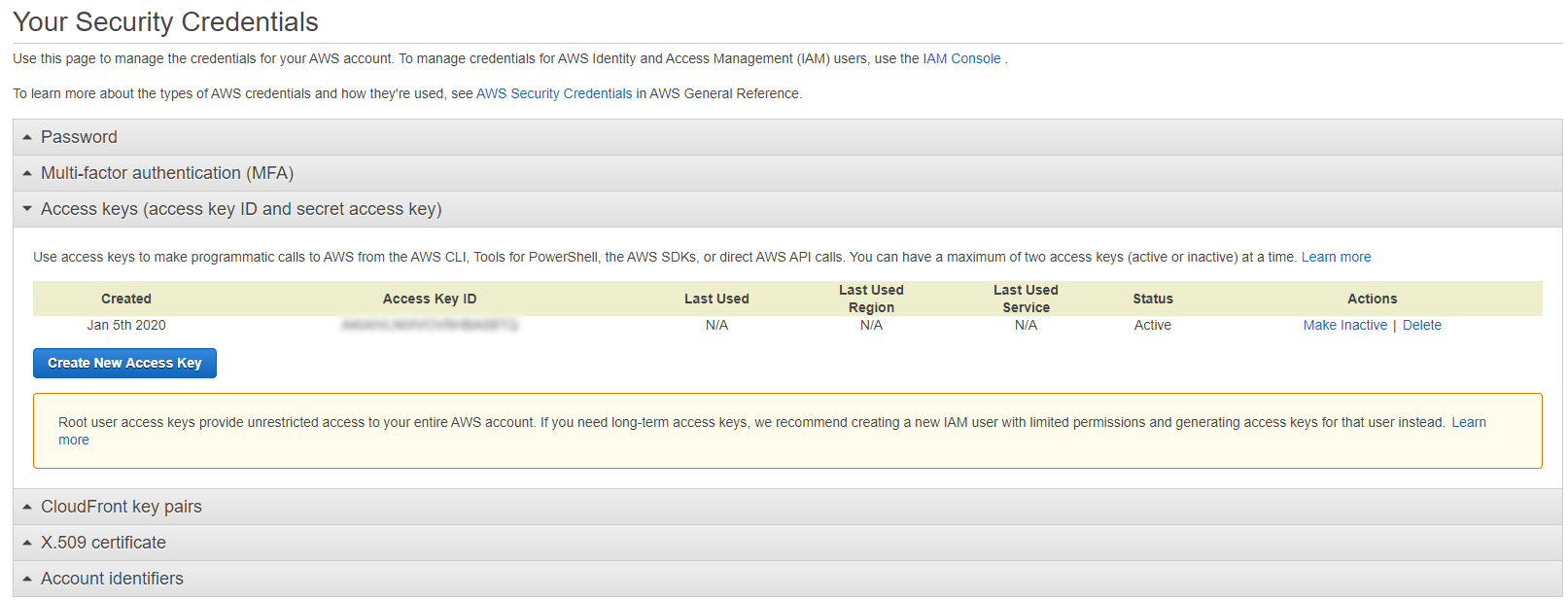Integrate Alexa with Google SecOps
This document describes how to integrate Alexa with Google Security Operations (Google SecOps).
Integration version: 7.0
Before you begin
To retrieve the access key ID and the secret access key, complete the following steps:
Sign in to your AWS account.
Click your username at the top right and select My Security Credentials from the menu.
In the Your Security Credentials page, expand the Access keys (access key ID and secret access key) option and click Generate New Access Key.

To display the generated key on the screen, click Show Access Key. To download it, click Download Key File.

Network
| Function | Default port | Direction | Protocol |
|---|---|---|---|
| API | Multivalues | Outbound | apikey |
Integration parameters
Use the following parameters to configure the integration:
| Parameter name | Type | Default value | Is mandatory | Description |
|---|---|---|---|---|
| Instance Name | String | N/A | No | Name of the instance you intend to configure integration for. |
| Description | String | N/A | No | Description of the instance. |
| Access key id | String | N/A | Yes | Access key generated in Alexa's console. |
| Secret access key | String | N/A | Yes | Generated in Alexa's console with Access key ID. |
| Run Remotely | Checkbox | Unchecked | No | Check the field in order to run the configured integration remotely. Once checked, the option appears to select the remote user (agent). |
For instructions about how to configure an integration in Google SecOps, see Configure integrations.
You can make changes at a later stage, if needed. After you configure an integration instance, you can use it in playbooks. For more information about how to configure and support multiple instances, see Supporting multiple instances.
Actions
For more information about actions, see Respond to pending actions from Your Workdesk and Perform a manual action.
Get URL Rank
Query Alexa for URL rank information. Broadly, Alexa rank represents a measure of a website's popularity, and shows how a website is doing compared to other sites. The indicated makes it a great KPI for benchmarking, and competitive analysis.
Parameters
| Parameter name | Type | Default value | Is mandatory | Description |
|---|---|---|---|---|
| Threshold | String | N/A | Yes | Rank e.g. 5. |
Run on
This action runs on the URL entity.
Action results
Script result
| Script name | Value options | Example |
|---|---|---|
| is_risky | True or False | is_risky:False |
JSON result
[
{
"EntityResult":
{
"TrafficData": [
{
"text": " ",
"DataUrl": [
{
"text": "domain.com",
"type": "canonical"
}],
"Rank": [
{
"text": "5"
}
]
}
],
"text": " ",
"Request": [
{
"text": " ",
"Arguments": [
{
"text": " ",
"Argument": [
{
"text": " ",
"Name": [
{
"text": "url"
}
],
"Value": [
{
"text": "domain.com"
}]}, {
"text": " ",
"Name": [
{
"text": "responsegroup"
}
],
"Value": [
{
"text": "Rank"
}]}]}]}]},
"Entity": "domain.com"
}
]
Entity enrichment
Entities are marked as suspicious (True) if they exceed the threshold. Else: False.
| Enrichment field name | Logic - When to apply |
|---|---|
| Alexa_Rank | Returns if it exists in JSON result |
| TrafficData | Returns if it exists in JSON result |
| text | Returns if it exists in JSON result |
| Request | Returns if it exists in JSON result |
Insights
| Severity | Description |
|---|---|
| Warn | A warning insight is created when the enriched file has a malicious status. The insight is created when the number of detected engines equals or exceeds the minimum suspicious Threshold set before scan. |
Ping
Test the connectivity to Alexa.
Parameters
N/A
Run on
This action runs on all entities.
Action results
Script result
| Script result name | Value options | Example |
|---|---|---|
| is_succeed | True or False | is_succeed:False |
Need more help? Get answers from Community members and Google SecOps professionals.
